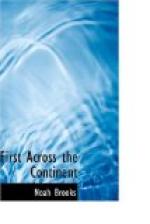Chapter X — To the Great Falls of the Missouri
Next day, June 8, the Lewis party returned to the main body of the expedition. They reported that timber was scarce along the river, except in the lowlands, where there were pretty groves and thickets. These trees, the journal says, were the haunts of innumerable birds, which, as the sun rose, sung delightfully:—
“Among these birds they distinguished the brown thrush, robin, turtle-dove, linnet, gold-finch, large and small blackbird, wren, and some others. As they came along, the whole party were of opinion that this river was the true Missouri; but Captain Lewis, being fully persuaded that it was neither the main stream, nor that which it would be advisable to ascend, gave it the name of Maria’s River. After travelling all day they reached camp about five o’clock in the afternoon, and found Captain Clark and the party very anxious for their safety. As they had stayed two days longer than had been expected, and as Captain Clark had returned at the appointed time, it was feared that they had met with some accident.”
As we now know, the stream that came in from the north was that which is still called Maria’s (or Marais) River, and the so-called branch from the southwest was the Missouri River. Lewis and Clark, however, were in the dark as to the relations of the two streams. Which was the parent? Which was the branch? After pondering all the evidence that could be collected to bear on the important question, the two captains agreed that the southern stream was the true Missouri, and the northern stream was an important branch. The journal says:




